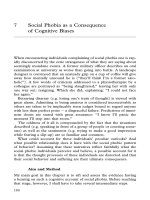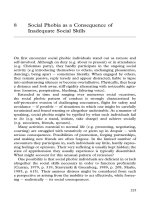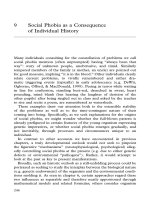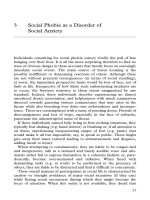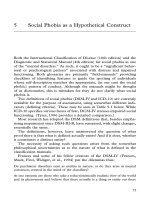Community-Based Social Marketing as a Planning Tool - Community and Regional Planning Masters Project pptx
Bạn đang xem bản rút gọn của tài liệu. Xem và tải ngay bản đầy đủ của tài liệu tại đây (1023.5 KB, 70 trang )
Community-Based Social
Marketing as a Planning Tool
Community and Regional Planning
Masters Project
University of Oregon-Architecture and Allied
Arts Department
Author:
Pamela Mae Pickens
1209 University of Oregon
Eugene, OR 97403-1209
Phone: 541-484-5502
Email:
September/2002
Community-Based Social Marketing as a Planning Tool September/2002 Page i
Special Thanks & Acknowledgements
People who have been of help:
Numerous people assisted me on this project with their advice and
encouragement. I would especially like to thank my father, Bill
Pickens, who by accident or by insight led me to the community-based
social marketing model long before I began graduate school. To my
mother, Bonnie Pickens, thank you for your editing skills and advice. I
can always count on you. Thank you to Jon Deininger for reminding me
that the only way to eat an elephant is one bite at a time. To our dogs
Zoe and Tumalo, thank you for reminding me to take breaks.
In addition, I would like to thank the staff of The EcoTeam Program,
Ellen Santasiero and Elaine Sigvaldsen, for aiding me with decision-
making, mailing lists, survey drafting and stuffing, and for being purely
honest and supportive through this process. May your new careers
blossom and be as rewarding as your time spent with EcoTeam. Ellen,
additional thanks is needed for committing to editing this report as part
of my exit project committee. To Megan Smith and Andre LeDuc, thank
you for serving as the faculty portion of my exit project committee. You
are excellent advisors. To Ed Weeks, thank you for your assistance
with survey analysis and for aiding in my understanding of the
Statistical Package for the Social Sciences computer program. I never
knew statistics could be so fun!
Project Advisors:
Andre LeDuc – Assistant Faculty and Director, Oregon
Natural Hazards Workgroup, University of Oregon.
Ellen Santasiero – Program Manager, The EcoTeam Program,
Deschutes County, Oregon.
Megan Smith- Assistant Faculty and Director, Resource Assistance
to Rural Environments & Community Service
Center, University of Oregon.
Project Funders:
Global Action Plan- Survey Grant.
Architecture and Allied Arts Department, University of Oregon- Travel
Grant.
Page ii September/2002 Community-Based Social Marketing as a Planning Tool
Community-Based Social Marketing as a Planning Tool September/2002 Page iii
Table of Contents
Special Thanks & Acknowledgements
______________ i
Table of Contents ____________________________________________ iii
Chapter 1 _________________________________________________________ 1
Introduction _____________________________________________________________ 1
1.1- Purpose _________________________________________________________ 1
1.2- Organization _____________________________________________________ 3
Chapter 2 _________________________________________________________ 6
Methodology ____________________________________________________________ 6
Chapter 3 _________________________________________________________ 9
Behavior Change Theory _________________________________________________ 9
3.1- Historical Roots of Behavior Change Science_________________________ 9
3.2- Behavior Change Theories ________________________________________ 11
Chapter 4 ________________________________________________________ 18
Community-Based Social Marketing _____________________________________ 18
4.1- Social Marketing _________________________________________________ 18
4.2- Community Based Social Marketing ________________________________ 18
Chapter 5 ________________________________________________________ 22
The EcoTeam Program and Survey Analysis______________________________ 22
5.1- “The EcoTeam Program”- A Sustainable Lifestyle Campaign in Deschutes
County, Oregon _____________________________________________________ 22
5.2- Survey Analysis _________________________________________________ 26
Chapter 6 ________________________________________________________ 34
Case Studies ___________________________________________________________ 34
6.1- “Go Boulder”- Transportation Plan for the City of Boulder, Colorado ____ 34
6.2- “Air Quality Public Education and Incentive Program”- Portland
Metropolitan Area, Portland, Oregon ___________________________________ 37
Chapter 7 ________________________________________________________ 41
Analysis and Recommendations _________________________________________ 41
7.1- Behavioral Science ______________________________________________ 41
7.2- Substantiated Psychology Theory __________________________________ 43
7.3- Program Effectiveness ___________________________________________ 44
7.4- An Effective Tool for Planning _____________________________________ 46
7.5 Recommendations________________________________________________ 49
Chapter 8 ________________________________________________________ 52
Conclusion_____________________________________________________________ 52
Appendix A _____________________________________________________ 54
Raw Survey Data and Transcripts ________________________________________ 54
Appendix B _____________________________________________________ 61
Page iv September/2002 Community-Based Social Marketing as a Planning Tool
Bibliography ___________________________________________________________ 61
Community-Based Social Marketing as a Planning Tool September/2002 Page v
Community-Based Social Marketing as a Planning Tool September/2002 Page 1
Chapter 1
Introduction
1.1- Purpose
Community developers and social planners often work as agents for
social and individual change. Whether a planner works in an advocacy
role attempting to change public policy or, a more neutral role, working
to implement existing regulations through a planning approval process,
planners influence behavior. Numerous examples of this influence exist
(see Table-1).
Table 1- Where Planners Influence Social/Individual Change
CATEGORY PLANNING EXAMPLES
Regulation Zoning, traffic laws, pollution laws, speed limits,
ordinances, and codes.
Voluntary
Action
Public outreach and education, recycling
campaigns, education, awareness campaigns, and
collaboration.
Incentive Carpool lanes, rebates, and coupons.
Not unlike planners, social and environmental psychologists work to
understand and promote human welfare. Their research advances
knowledge of human factors that contribute to social issues such as
environmental degradation and population growth. It is broad issues
such as these that planners are often involved in, designing and
implementing mitigation programs. These programs are implemented
at all levels of the community including neighborhood, city, state,
national, and international. Some psychologists are beginning to
identify a gap between psychological research and delivery of programs
Page 2 September/2002 Community-Based Social Marketing as a Planning Tool
that planners work on, especially those programs that use voluntary
action and incentive approaches to change behavior (D Winter, S.
Oskamp, D. McKenzie-Mohr). Although this gap is a perceived
problem, psychologists do not emphasize planning related social issues
as core to their field. As psychologist Deborah Du Nann Winter points
out, “In spite of its talented membership, division 34 (Environmental
and Population Psychology) has been and continues to be a very small
division of the American Psychological Association (APA), because most
psychologists do not see environmental or population problems as
central to their work” (D. Winter, p. 516). Instead, this gap could be
filled by an interdisciplinary approach. An approach like this would
seek to have planners use tools provided by the psychology field to
implement social change. Examples would include models, theories,
research, and processes developed within the psychology field and
applicable to the planning field.
Although planners may be the logical professionals to implement social
change, psychologists do have substantial knowledge of human
behavior and behavioral change. Theories that have emerged from the
psychology field, such as Attitudinal-Behavioral Relationship, Cognitive
Dissonance, and Social Diffusion, predict how human behavior is
altered through various environmental, educational, and social stimuli.
This knowledge should be applied by planners when developing and
implementing programs that address a wide variety of planning issues
such as public transportation use, water and energy efficiency, solid
Community-Based Social Marketing as a Planning Tool September/2002 Page 3
waste management, and community or neighborhood building. One
behavior change model that uses knowledge from the psychology field to
assist planners in program development is called “community-based
social marketing”. Environmental psychologist and professor of social
psychology at St. Thomas University in New Brunswick, Canada, Doug
McKenzie-Mohr developed this model.
The purpose of this report is to analyze the effectiveness of the
McKenzie-Mohr’s community-based social marketing model in the
planning field. The issues of household resource planning,
transportation planning, and air quality management planning are
specifically addressed. If the community-based social marketing model
proves to be a useful tool for planning professionals, it will serve as an
example of a successful interdisciplinary approach to improving human
welfare. In addition, positive results may be an indicator that outreach
by planners into social and psychology disciplines will help them design
and implement planning programs that implement complex human
behavioral change.
1.2- Organization
The report is organized to give readers a broad understanding of
behavior change theory before reviewing case studies where the
community-based social marketing model is applied. This chapter,
Chapter 1-Introduction, furnishes the purpose and organization of the
report. Chapter 2-Methodology describes the means by which
information was gathered for the report. Chapter 3- Behavior Change
Page 4 September/2002 Community-Based Social Marketing as a Planning Tool
Theory provides a history of behavior change science and describes
three well-known theories of behavior change. Chapter 4- Community-
Based Social Marketing describes both the concepts of social marketing
and the behavior change model: community-based social marketing.
Chapter 5- The EcoTeam Program and Survey Analysis is an in-depth
study of “The EcoTeam Program”, which is an on-going non-profit
program in Deschutes County, Oregon, whose mission is to reduce
resource consumption at the household and individual levels. This
chapter describes the program and provides results from the “Deschutes
County EcoTeam Participant Survey”. The survey was conducted as
original research to aid in analyzing the effectiveness of the community-
based social marketing model. Chapter 6- Case Studies offers two
additional examples of case studies where principles of the community-
based social marketing model have been applied to specific planning
issues. These case studies parallel two of the report’s primary topics,
transportation and air quality planning. The first case study, “Go
Boulder”, presents how the city of Boulder, Colorado, applied
community-based social marketing principles to reduce Vehicle Miles
Traveled (VMT). “Go Boulder” began in 1989 and is an ongoing
program. The second case study, “Air Quality Public Education and
Incentive Program”, describes a State initiated program to reduce air
pollution in Oregon. The program was piloted in Portland, Oregon, over
a three-year period, from 1995-1998. Chapter 7- Analysis and
Recommendations explores the effectiveness of the community-based
social marketing model. Chapter 8- Conclusions summarizes and
Community-Based Social Marketing as a Planning Tool September/2002 Page 5
concludes the report. Appendix A- Deschutes County EcoTeam
Participant Survey provides a full text of the survey. It shows raw
percentages for each potential answer in the survey. A transcript from
Q-16, a write-in comment question, is supplied. Appendix B–
Bibliography provides a complete listing of texts, journals, and Internet
websites used to research this report.
Page 6 September/2002 Community-Based Social Marketing as a Planning Tool
Chapter 2
Methodology
The purpose of this project is to analyze the effectiveness of the
community-based social marketing model as applied to three distinct
planning related topics- consumption reduction, transportation, and air
quality control. The project utilizes three methods to obtain
information: a literature review, a survey, and case studies.
Research was designed so that various methods of information
gathering interrelate. The process used is highlighted below:
1. The EcoTeam case study was identified as a program of
interest.
2. A literature review on behavior change, social marketing, and
community-based social marketing was conducted.
3. It was determined that the EcoTeam Program could provide a
case study for this analysis.
4. Other community-based social marketing case studies were
identified.
5. A survey instrument was used to provide specific data on the
EcoTeam Program and the perceived effect of community-
based social marketing principles in the surveyed population.
Literature Review
Reviews of books, journals, and Internet resources were conducted to
gain an understanding of behavior change theory, social marketing
approaches, and the community-based social marketing model. A
discussion of the findings is provided in Chapters 3 and 4. A complete
bibliography is provided in Appendix B- Bibliography.
Community-Based Social Marketing as a Planning Tool September/2002 Page 7
Survey
An in-depth analysis was conducted for The EcoTeam Program, a non-
profit organization that serves Deschutes County, Oregon. In addition
to describing the program using existing sources, the author designed
an original household survey for research purposes. The survey was
designed with input from The EcoTeam Program staff and the exit
project faculty committee for this report. A first draft of the survey was
e-mailed on March 15
th
, 2002. Comments were received and additional
drafts were written and reviewed for the following three weeks. A final
draft was accepted on April 9
th
, 2002. The final product, entitled
“Deschutes County EcoTeam Participant Survey”, is a four-page, 16-
question survey, on 8.5” x 11” paper. Surveys were printed on both
sides of white 11” x 17” recycled paper. The survey included 15
multiple-choice questions, six of which included an option to write in an
answer of “other”, and one of which was “fill in the blank”. The final
question provided a box for respondents to write in any additional
comments about their experience with The EcoTeam Program (see-
Appendix A).
Survey recipients were all EcoTeam Program participants living in
Deschutes County, Oregon. The EcoTeam Program staff randomly
chose recipients using files kept for record purposes. Surveys were
mailed on April 24, 2002. A deadline of May 10, 2002, was set for
returning the surveys, but surveys were accepted through May 15,
Page 8 September/2002 Community-Based Social Marketing as a Planning Tool
2002. Of the 250 mailed surveys, 40 were returned by the post office
because of changed or incorrect addresses and 76 completed surveys
were returned. This yields a response rate of 36.0%.
Case Studies
In order to locate case studies that applied community-based social
marketing principles, the author used a website (www.cbsm.com)
provided in the book Fostering Sustainable Behavior- An Introduction to
Community-based Social Marketing, by Doug McKenzie-Mohr and
William Smith. This website houses hundreds of case studies where
the community-based social marketing model is applied. The two case
studies chosen for this project are: “Go Boulder” and “Air Quality
Public Education and Incentive Program”. They were chosen because
they exemplify application of the model to planning related issues.
Community-Based Social Marketing as a Planning Tool September/2002 Page 9
Chapter 3
Behavior Change Theory
3.1- Historical Roots of Behavior Change Science
The community-based social marketing model is based on behavior
change science and theory; therefore, it is essential to gain an
understanding of this science in order to evaluate the effectiveness of
the model. The following chapter summarizes findings of a literature
review on behavior change science and theory.
Formal study of behavior and choice emerged in the late 19
th
and early
20
th
centuries. During this time period, the work of Russian
physiologist Ivan P. Pavlov was particularly significant. Pavlov
experimented with digestive systems in dogs and found that certain
stimuli in the environment, such as noise, shock, or light, elicit reflex
responses. His findings suggest one way in which behaviors could be
learned. Over time his concepts, called “respondent conditioning”, were
expanded “to explain virtually all learning, including such broad areas
as the learning of language, the acquisition of knowledge, and the
development of deviant behavior” (Kazdin, p.9). Kadzin goes on to
suggest that Pavlov’s concepts were overextended because they did not
give an accurate account of all areas of learning. Kadzin says, “more
research has shown that conditioning itself is more complex than
Page 10 September/2002 Community-Based Social Marketing as a Planning Tool
originally thought. For example, certain kinds of connections are more
easily learned than others, and pairing stimuli does not automatically
lead to learning” (Kadzin, p.9). Beginning with the experimentation of
Ivan Pavlov, the attempt to understand and predict human behavior
has grown into a very large and complex discipline in the fields of
sociology and psychology.
By the mid-twentieth century, psychologists such as B.F. Skinner would
be influenced by Pavlov’s findings. Skinner explored the impacts that
various external consequences might have on behavior. He helped to
distinguish between learning resulting from respondent conditioning,
found by Pavlov, and learning resulting from consequences received
from similar past behavior. Skinner’s findings showed, “responses that
operate on the environment are strengthened and weakened as a
function of the events that follow them” (Kadzin, p. 10). Most of the
behaviors performed in everyday life such as reading, walking, working,
and talking, fall under this type of learning behavior.
Research continues today to more thoroughly explain what causes
behavior and behavior changes in individuals. Two main paradigms
are used to explain the concept of behavior. One group of scientists and
theorists who emerged from Pavlov’s experimentation argue that
behavior is a result of intrapersonal, cognitive information processing.
Choice, therefore, is the outcome of deliberation and decision-making.
Community-Based Social Marketing as a Planning Tool September/2002 Page 11
Using this paradigm, attempts to change behavior would focus on the
internal characteristics of an individual. Another group, commonly
associated with the psychologist, B.F. Skinner, argue that behavior is a
result of previous behaviors. Choice, therefore, is influenced by
environmental and inherited stimuli. Using this paradigm, attempts to
change behavior would focus on external factors influencing the
individual (Foxall, p.12). As the results of Pavlov and Skinners’
experimentation verify, the study of behavior is complex and sometimes
contradicts itself, therefore, any attempts to change behavior can not be
100% accurate 100% of the time.
3.2- Behavior Change Theories
Next, three theories along with supporting examples, are described in
order to exemplify how behavior change can occur in individuals.
Attitudinal-Behavioral Relationship
The first behavior theory described here is called the Attitudinal-
Behavioral Relationship, or the “AB”. It states that a person’s behavior
is largely determined by factors that exist within the individual. Of all
these elements attitude (beliefs, emotions, feelings, actions tendencies)
is of pre-eminent importance in shaping behavior. The prediction of
behavior, therefore, depends upon accurately measuring attitudes. The
key to changing behavior is in the modification of attitude,
predominantly through the presentation of informative or persuasive
messages.
Page 12 September/2002 Community-Based Social Marketing as a Planning Tool
A case study conducted at the University of California, Santa Cruz
serves as an example that the use of persuasive messages combined
with modeling effectively changes individual behavior. “The male
shower room had a sign that encouraged the showers be turned off
while users soap up. More specifically the sign read: ‘Conserve water:
1. Wet down. 2. Water off. 3. Soap. 4. Rinse.’ This sign apparently
had little effect on behavior. On average, only 6% of users were found
to comply. One possibility was that people didn’t see the sign.
However, a survey of a random sample of students demonstrated that
93% were aware of the sign and its message. Elliot Aronson and
Michael O’Leary (the researchers) reasoned that students might be far
more likely to comply with the sign if they observed another student
following its instructions. To test this possibility, an accomplice entered
the male shower room in the athletic complex and proceeded to the back
of the room and turned on the shower. When another student entered,
the accomplice turned off the shower, soaped up and then turned on the
shower once more to rinse off. All this was done with his back to the
other student and without eye contact. When the accomplice modeled
water conservation in this way, the percentage of students who turned
off the shower to soap up shot up to 49%. Furthermore, when two
accomplices modeled water conservation, the number of people who
followed suit rose to 67%. … While the sign by itself was ineffective in
altering the behavior of those using the shower room, when it was
combined with the norm, behavior changed dramatically” (McKenzie-
Mohr and Smith, p. 74).
Community-Based Social Marketing as a Planning Tool September/2002 Page 13
Cognitive Dissonance
The second behavior theory described here is referred to as “cognitive
dissonance” or “contact hypothesis”. This model states that a person’s
attitude will change once their behavior changes. This theory can be
used to exemplify the benefits of applying regulations to promote
certain desired behavior. A few examples include laws for speeding,
desegregation, and pollution.
A case study on racial integration in the US Army serves as an example
for cognitive dissonance. This planned integration was based on the
notion that individual discrimination and prejudice toward members of
a minority group will diminish when they have direct interpersonal
contact, and that negative stereotypes of the minority group are
disconfirmed by this contact.
The decision to desegregate the military came from President Truman’s
Executive Order 9381. The committee that formed to uphold the Order
abolished the quota system and pressured the Army to integrate its
training camps in 1950. “The armed forces were integrated in two
phases. During the first phase, in the 1950’s, organizational integration
put an end to any formal discrimination in recruitment, training,
retention, and on-base living arrangements. The second phase,
leadership integration, would not occur for another quarter of a century”
(Moskos and Butler, p. 31).
Page 14 September/2002 Community-Based Social Marketing as a Planning Tool
As of 1995, about half of all blacks in military uniform were enlisted in
the Army. These 145,000 African-Americans made up 27% of all Army
personnel on active duty (Moskos and Butler, p. 6). Monitoring and
planning for continued integration was the responsibility of soldiers
within the Army. “The workhorse of the Army’s racial policies is the
equal opportunity advisor (EOA). In every command, at brigade level
or higher, a full-time EOA is responsible for monitoring racial incidents,
looking at patterns of race in assignments and promotions, and
generally attending to interracial awareness through events like
commemorations of Black History Month. EOAs, whether full- or part-
time, are supposed to be the commander’s eyes and ears for the racial
climate in the unit. In 1994 the Army had approximately 350 full-time
EOAs, a ratio of about one to every 1,500 soldiers. In the past, most
EOAs were black; today, about half of all EOAs are white, about a third
are black, and the rest represent other minorities.” (Moskos and
Butler, p. 54-55).
The process of integration has taken over 30 years, but it appears that
the races get along remarkably well. “A visitor to an Army dining
facility is likely to see a sight rarely encountered elsewhere in American
life: blacks and whites commingling and socializing by choice. This
stands in stark contrast to the self-imposed racial segregation in most
university dining halls today- not to mention within most other locales
Community-Based Social Marketing as a Planning Tool September/2002 Page 15
Number o
f
Innovators
x
y
z
Time
in our society. As a rule of thumb, the more military the environment,
the more complete the integration. Interracial commitment is stronger
in the field than in garrison, stronger on duty than off, stronger on post
than in the world beyond the base. Even in the grueling conditions of
deployments to the Persian Gulf, Somalia, or Haiti, not a single
incident occurred that was severe enough to come to the attention of the
military police- not one.” (Moskos and Butler, p. 2). By regulating
behavior over a 30-year period, the US Army has successfully altered
the interactive attitude between whites and blacks.
Diffusion Theory
The final theory described here is called “diffusion theory”. This theory
broadens behavior research beyond attitude and belief modification to theory on
diffusion of new ideas and innovations. Research in the fields of sociology,
education, public health, communication, marketing, and geography shows that
dispersal of new ideas and innovations throughout large populations is
predictable. Everett M. Rogers chronicles the study of diffusion theory in his
book Diffusion of Innovations. Each
study finds that innovations, which
include new products and new
ideas, diffuse in an S-shaped curve
over time, and innovators, or those
changing first, have higher
socioeconomic status than later
adopters (see Figure-1).
Fi
g
ure 1- Diffusion Theor
y
Dia
g
ram
Source: Pickens
,
P. 2002.
Page 16 September/2002 Community-Based Social Marketing as a Planning Tool
The earliest studied example of diffusion of new ideas was documented by an
Iowa State University study in 1943. The researchers, professor Bryce Ryan
and masters student Neil Gross, studied hybrid corn diffusion in two small Iowa
communities. “The innovation of hybrid corn was one of the most important
new agricultural technologies when it was released to Iowa farmers in 1928.
The new seed ushered in a whole set of agricultural innovations in the 1930s
through the 1950s that amounted to an agricultural revolution in farm
productivity. Hybrid corn yielded about 20 percent more per acre than the open-
pollinated varieties that it replaced.” (Rogers, p.31).
The study was conducted by first collecting then analyzing personal interviews
from 259 farmers. The results follow: “All but two of the 259 farmers had
adopted hybrid corn between 1928 and 1941, a rather rapid rate of adoption.
When platted cumulatively on a year-by-year basis, the adoption rate formed an
S-shaped curve over time. After the first five years, by 1933, only 10 percent of
the Iowa farmers had adopted. Then, the adoption curve “took off”, shooting up
to 40 percent adoption in the next three years. Then the rate of adoption leveled
off as fewer and fewer farmers remained to adopt the new idea.” (Rogers, p.33).
Each of these three theories, attitudinal-behavioral relationship, cognitive
dissonance, and social diffusion, attempt to explain how human behavior can be
influenced and changed. Each has withstood rigorous testing over time and has
emerged as a standard in the psychology field. The community-based social
marketing model applies elements of these theories to promote behavior change.
In addition, these theories serve as foundations for programs created in the
Community-Based Social Marketing as a Planning Tool September/2002 Page 17
advertising and marketing fields, whose goal is to influence consumer behavior
and attitude in order to sell products and services.

